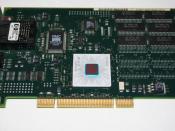Cover Page
Network systems and
Data communication
Design a network infrastructure
Because networks are configured in many ways, network systems and data communications analysts are needed to design, test, and evaluate systems such as local area networks (LANs), wide area networks (WANs), the Internet, intranets, and other data communications systems.
The term WAN (Wide Area Network) refers to a network, which covers a large geographical area, and use communications circuits to connect the intermediate nodes. WAN's are used across a city, country or even around the globe. Typical transmission rates are 2 Mbps, 34 Mbps, 45 Mbps, 155 Mbps, and 625 Mbps but can be even more than this. A WAN consists, basically, of two or more LANs (Local Area Network), which are connected to each other using WAN technologies under a high-speed communication. The largest and probably the best example of a Wide Area Network is the Internet. WAN technologies generally function at the lower three layers of the OSI Model: the Physical Layer, the Data Link Layer, and the Network Layer (all layers are shown in order below).
. Bridges, routers and multiplexers and other devices are used for correct data transmission. Some WANs are extremely widespread (global), but most do not provide true global coverage. Organizations supporting WANs using the Internet Protocol are known as Network Service Providers (NSP's). These form the core of the Internet.
The OSI (Open System Interconnection) Model: -
Application
Presentation
Session
Transport
Network
Data Link
Physical
Addressing and routing
On a Wide Area Network, the routing of data is done mainly using TCP/IP (Transmission Control protocol/Internet Protocol).
TCP is the protocol, which "enables two hosts to establish a connection and exchange streams of data. TCP guarantees delivery of data and also guarantees that packets will be delivered in the same...


